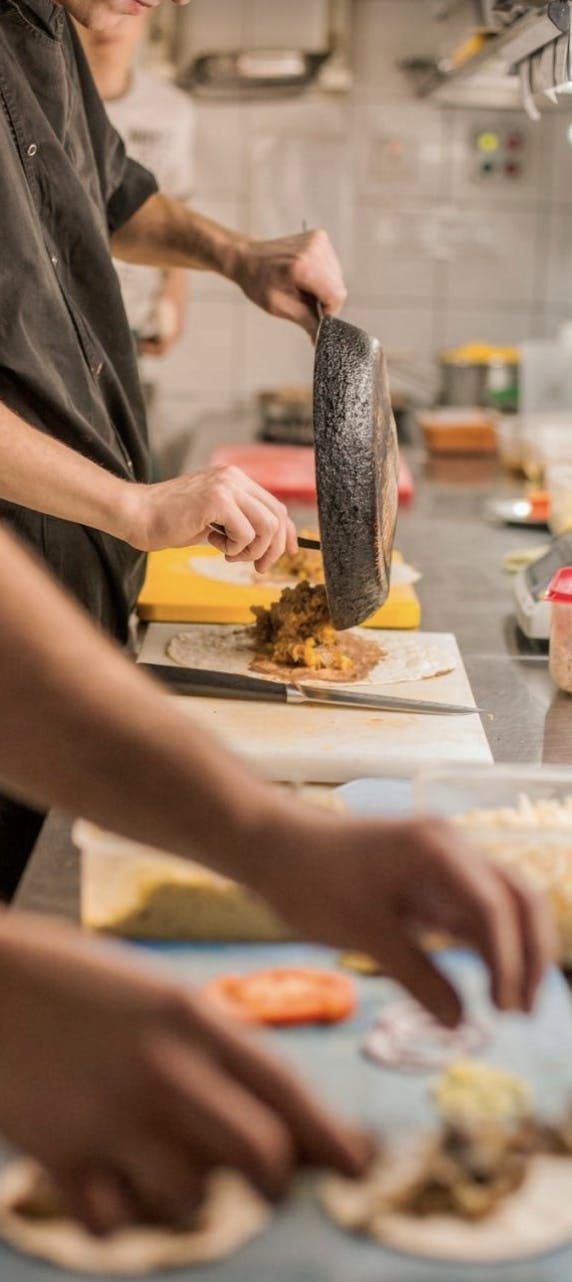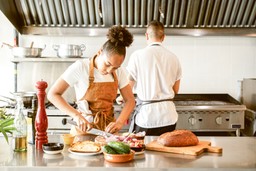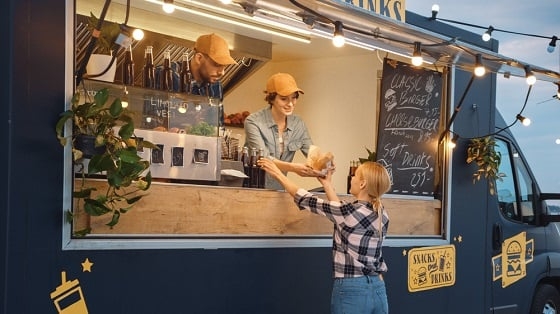5 Reasons Why Restaurants Fail
Table of Contents
CloudKitchens
How many tacos can be delivered from a 1000sqft restaurant?
The same amount as a 200sqft ghost kitchen.
It’s no secret that the restaurant business is one of the most competitive, with a higher failure rate compared to other industries. About 60% of restaurants, among the many different restaurant types, fail within the first year, while 80% shut their doors within the first five years. It’s also safe to say that such failures can come at a cost.
Due to a great deal of overhead, such as equipment, staff, and space, restaurants typically require a significant initial investment for a chance at successful restaurant ownership.
Before opening a new restaurant, budding restaurateurs must first consider the question, why do restaurants fail? By learning how to circumvent the most common mistakes, new owners can set themselves up for success and ensure their new restaurant flourishes. We’re diving into that next.
1. Lack of vision
Restaurants are far more than just a menu. As a food service business owner, you need to have a clear vision of your restaurant’s goals and what your mission is within the restaurant industry. You can hone in on these goals by asking yourself questions such as:
- Why does your restaurant exist?
- Why is it located where it is?
- Why do you serve the types of food on your menu?
- What guides your restaurant’s decor and ambiance?
- What determines your pricing system?
- Who is eating at your restaurant, and why?
- Who is not eating at your restaurant, and why?
While these may seem like simple questions, their answers should support one another rather than clash—and they should clearly communicate who you are to potential customers. Restaurants that thrive have a unique brand identity that not only attracts new customers but also repeat customers.
Tips for finding your vision
Excellent planning and organization are the keys to making your restaurant operation vision come to life. But before you can plan, you need to know what your vision is.
You can start by writing a clear mission statement and restaurant business plan. The thesis of this mission statement should clearly answer why you want to open this restaurant––not any restaurant, but your restaurant.
If you want to open a Bavarian restaurant in Los Angeles, for example, a poor mission statement would be “to make money.” A high-profit margin might be the outcome of a successful restaurant, but it’s not a goal that can provide a foundation for the restaurant itself.
On the other hand, if you want to open a Bavarian restaurant in Los Angeles to introduce the city to an underrepresented cuisine you grew up with, you’re off to a better start. This mission statement will influence the values of your establishment, such as:
- Family recipes and traditional dishes
- Homey ambiance and hospitable staff
- Staff dressed in traditional lederhosen
A restaurateur’s mission statement should effectively answer why you want to open this restaurant and why it should be opened by you.
2. Not enough industry experience
No matter how delectable your food is, a lack of experience in the restaurant industry can lead to poor decision-making and ineffective leadership.
Nearly half of all restaurants in the United States are chain restaurants owned by franchises or conglomerates, meaning they’re operated by highly experienced corporate teams. Among the other half operated independently, owners often have years of experience in the business before becoming restaurant owners themselves.
Again, it takes a lot more to open a restaurant than crafting a menu, decorating the dining room, and hiring staff. Owners must also know how to:
- Uphold health and safety codes
- Maintain relationships with local papers, food bloggers, and reviewers
- Establish relationships with food and supply vendors
- Incorporate modern technology
- Master hospitality management and uphold customer service
- Evaluate staff performance
- Assess and act upon a lack of success
- Know how to both compromise and stick to their guns
A holistic understanding of the restaurant industry tends to come from years in the trenches, and naive owners without such experience are often the most prone to failure.
Tips on starting a restaurant with little experience
If you have little or no restaurant experience, this doesn’t mean you can’t open a restaurant—but you’ll benefit from having the right support from the start. The first step in learning how to start a restaurant business would be to hire an experienced support staff that can lead you in the right direction. This includes a:
- General Manager, who will oversee employees, training programs, PR and marketing, process optimization, and other day-to-day operations
- Assistant Manager, who will help the General Manager
- Executive Chef, who will help plan the menu and oversee the kitchen
- Kitchen Manager, who will oversee the needs of the kitchen
- Food and beverage manager, who will be responsible for inventory and health codes
These positions are just the tip of the iceberg when it comes to restaurant staff. However, they will be the most instrumental in guiding an inexperienced restaurant owner.
If you’re wondering how to save a failing restaurant, strengthening your staff with the above positions can be a good start. You can also bolster your experience with the services of companies like CloudKitchens, which provides you with the experience you need to back up your vision.
3. Not enough operating capital
What is the cost to start a restaurant? Restaurants typically require a significant initial investment, ranging between $250,000 and $450,000. Expenses covered in this amount include:
- Fees to set up your business, whether as a corporation or LLC
- A security deposit for your location, which is usually one to three months of rent
- Equipment, such as hoods, grills, ovens, stoves, stainless steel prep tables, shelving, hot tables, cold tables, a Point of Sale (POS) system, and a walk-in refrigerator
- Cookware, plates, glasses, utensils, etc.
- Furniture, including fixtures, countertops, workstations, tables, chairs, and decorative shelving
- Leasehold improvements, which typically include construction costs for electrical installations, hood venting, plumbing, heating, and air conditioning
- Signage and advertising
- Start-up inventory management, including food and beverage
- Reverse capital in case of any financial shortfalls
Many of these expenses, such as equipment, can be mitigated by occupying the space of a recently closed restaurant. That said, many of these expenses will reappear every month, so you’ll want to be prepared for them to ensure your restaurant succeeds.
Tips on creating a solid financial foundation
The greatest mistake a restaurant can make when raising initial investment is not keeping enough reserve capital. Starting a restaurant doesn’t just require one initial investment. Instead, many of the upfront costs will reappear each month––furniture will break, staff and utilities will need to be paid, and food will need to be restocked.
Because restaurant profits are marginal, restaurants typically don’t reach their break-even points during the first year. When you’re first getting your restaurant off the ground, be sure to have a plan in place for a lack of cash flow or working capital in the first few months and a plan for how you’ll pay the bills in the meantime.
4. Poor location
Location, location, location.
When it comes to setting up a restaurant, location can have a significant impact on not just traffic, but also, labor costs, utility bills, and food expenses. Choosing a location that helps your restaurant succeed isn’t just about picking the trendiest or most upscale area—in fact, those locations may have the most significant costs. More importantly, those areas will have the most competition.
Location is arguably the most important decision you will make, and it’s a game of cost-benefit analysis. Choosing the right one can help to ensure your restaurant isn’t eclipsed by competitors and that you don’t break the bank trying to reach customers.
Tips on choosing the right restaurant location
Choosing the right restaurant location is all about asking the right questions. These considerations can help guide you to find the perfect balance of features your new location may offer:
- Competitors: Are there similar restaurants in the area?
- Foot traffic: How densely populated is the area? Will you get walk-in customers, or will you need to rely on advertising?
- Clientele: Are the people in this area your target audience? Do they support new restaurants?
- Ambiance: What is the area like day and night? Does it fit your restaurant’s brand?
- Accessibility: Is there parking? Is it close to public transportation?
- History: How have new restaurants fared in this location in the past?
5. Inconsistent food and service
Restaurant success relies on its reputation. While advertising and branding are important, the most effective way to attract new customers is by making your current ones happy—aka, by earning positive reviews and word-of-mouth recommendations.
Reviews and recommendations go both ways––a potential customer may go to restaurants that are recommended to them, and they avoid restaurants they’re warned of. Reviews in particular can majorly factor into a person’s choice of where to dine. Just consider these facts:
- 94% of diners reference online reviews before visiting a restaurant.
- A one-star increase in Yelp rating leads to a 5–9 percent increase in revenue.
The only way for a restaurant to uphold its reputation is to consistently maintain excellent food quality and customer service. By sticking to this standard, a restaurant can ensure the highest possible percentage of positive reviews and the lowest possible percentage of negative reviews.
Tips on creating an outstanding reputation
Providing outstanding food and service should therefore be your key focus as you seek to build a fantastic reputation. Restaurant owners can optimize their food and service operations by:
- Hiring experienced professionals
- Implementing sufficient training
- Ensuring good communication between the front and back-of-house
- Purchasing high-quality ingredients and equipment
- Maintaining their facilities
Owners can also be hands-on by maintaining a physical presence in the dining room. By greeting guests and ensuring their experience is memorable, an owner can create relationships within the community and establish a positive reputation.
When negative reviews do happen, owners can do damage control by responding to them. Nearly 45% of consumers are more likely to visit a restaurant that responds to negative reviews. To properly respond to a negative review, you can:
- Thank the customer for their business
- Highlight something good from the review
- Apologize for what went wrong
- Explain what you’re doing to ensure it won’t happen again
- Move the situation offline
- Invite them back
When responding to reviews, it is also important to use correct grammar and to leave emotion at the door.
Set your restaurant up for success with CloudKitchens
There are many steps you can take to give your restaurant a better chance of success. Avoiding the above five reasons why restaurants fail should be at the top of your list, but there’s also an opportunity we haven’t mentioned—opting to start your business as a ghost kitchen.
Ghost kitchens are a modern revolution that is projected to become a trillion-dollar industry. By relying on only online orders, ghost kitchens remove the overhead necessitated by dining rooms and front-of-house staff. As a result, prospective restaurateurs can launch their business with limited initial investment.
Ghost kitchens can be launched with only:
- 200 square feet of real estate
- Four staff members
- $30,000 investment
When you open your ghost kitchen with CloudKitchens, you can launch in as little as six weeks. Best of all, we provide everything your ghost kitchen needs, from staff to facilities.
We have locations in most major metropolitan areas in the US and even ghost kitchens in Toronto! Find out how CloudKitchens can help you achieve your culinary dreams. Find out how CloudKitchens can help you achieve your culinary dreams.
Explore ghost kitchen locations across the US:
- Ghost kitchens in San Francisco
- Ghost kitchens in LA
- Ghost kitchens in NYC
- Ghost Kitchens in Toronto
- Ghost Kitchens in Atlanta
- Ghost Kitchens in Dallas
- Ghost Kitchens in Chicago
- Ghost Kitchens in Denver
- Ghost Kitchens in Miami
| DISCLAIMER: This information is provided for general informational purposes only and the content does not constitute an endorsement. CloudKitchens does not warrant the accuracy or completeness of any information, text, images/graphics, links, or other content contained within the blog content. We recommend that you consult with financial, legal, and business professionals for advice specific to your situation. |
Sources:
CNBC. The No. 1 thing to consider before opening a restaurant.
https://www.cnbc.com/2016/01/20/heres-the-real-reason-why-most-restaurants-fail.html
NPD. Despite A Rough Two Years, U.S. Independent Restaurants Still Represent Over Half of U.S. Commercial Restaurant Units and Are Recovering. https://www.lightspeedhq.com/blog/why-do-restaurants-fail/.
Forbes. 8 Costs To Consider When Opening A Restaurant. https://www.forbes.com/sites/garyocchiogrosso/2021/07/30/8-costs-to-consider-when-opening-a-restaurant/?sh=263a53a02742.
Small Biz Trends. 94% of Diners Will Choose Your Restaurant Based on Online Reviews.
https://smallbiztrends.com/2018/06/how-diners-choose-restaurants.html.
Harvard Business School. Reviews, Reputation, and Revenue: The Case of Yelp.com. https://www.hbs.edu/ris/Publication%20Files/12-016_a7e4a5a2-03f9-490d-b093-8f951238dba2.pdf
Reviewtrackers. Online Reviews Statistics and Trends: A 2022 Report by ReviewTrackers.
https://www.reviewtrackers.com/reports/online-reviews-survey/.
Restaurant Dive. How the pandemic accelerated the US ghost kitchen market ‘5 years in 3 months’. https://www.restaurantdive.com/news/how-the-pandemic-accelerated-the-us-ghost-kitchen-market-5-years-in-3-mont/585604/
More insights & stories
There’s more where that came from.
Get in the know and check out our additional insights




